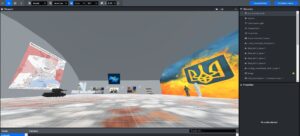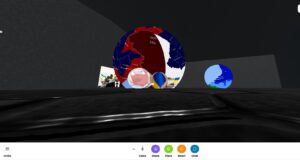“All models are wrong, but some are useful.”
George E. P. Box
Premise
Raising awareness of personal epistemic bubble by presenting categorized browsing history in virtual reality.
Synopsis
Information blindness leads to belief polarization, which has a corrosion effect on democracy. By making people more aware of their own epistemic (cognitive) bubble, there is a higher probability for them to be more tolerable of opposing opinions. In the digital era, where most people seek to consume information online, browsing history represents potentially valuable and useful data in raising awareness of their information “nutrition” intake. A creative approach was taken in an attempt to transfer and present such data in Virtual reality, using Mozilla Hubs.
Substantiation
Introduction
Epistemic bubble
“An epistemic bubble is a social epistemic structure in which other relevant voices have been left out, perhaps accidentally” (C. T. Nguyen, 2018:1). Unintentional lack of exposure to a broader variety of valid arguments and relevant information is the major cause of the epistemic bubble occurrence. For the democracy to function, it is of utmost importance that its’ citizens are well informed, and not fall into information blindness (Indriani, Prasanti, Permana, 2020). The major emphasis is on information awareness: realizing one own individual choices on information selection.
Browsing history
So why is browsing history a good and important source for understanding such phenomena? By no surprise Internet’s role is considered and perceived as the fundamental pillar of the modern information society. Therefore we are considered “digital citizens” (Mossberger, Tolbert dan McNeal, 2007) due to the rising number of activities being transferred online. Following Woods (2005) idea of the “Actually Happens Rule”, which claims that in order to understand what should an individual do, first investigate what has actually been done already. Thus, browsing history represents a list of online activities and information behavior, which allows insights and presents the opportunity to raise awareness of personal epistemic bubble.
Note: browsing history itself might not represent sufficient data for such a broad phenomenon. However, I assume it is a valid attempt to test since it represents the information-seeking behavior of the individual in the digital society.
Virtual Reality
As Xiong, Hsiang, He, Zhan, and Wu (2021) state that virtual reality represents the next generation of platforms that can provide an immersive and deeper human-digital interaction. By bringing the digital concept into virtual reality, it enables humans to experience that information in a new environment, and perhaps in a novel way. To conclude with Greengard’s (2019) idea of telexistance, which not only allows people to be present in some meetings when there is a physical barrier but also allows exploration and creation of novel human and digital interaction by bridging two separated elements in one extended reality.
Approach
Users and data
Due to the current lack of coding knowledge to create a classification algorithm for browsing history categorization (topic modeling), a survey on browsing history was conducted. For a better immersive experience of virtual reality, it is important that users have some connection to the content of it. Therefore, users (5) with similar interests and preferences were selected, based on their input in the above-mentioned survey, for the following user testing of the model.

- Piechart: domestic or international affairs engagement

- Barchart: “politics and society” being chosen as the topic that interests the questioned users the most.

- Screenshot of the responses for particular topics in browsing history
Therefore, international politics and society issues were chosen as the topic that most of the users are interested in, more specifically the Ukraine-Russian war as the prevalent and most commonly found information-seeking behavior in browsing history.
Tool
As for the tool, I used Mozilla Hubs, a 3D virtual spaces tool, which offers many technical possibilities from importing your own media, constructing the virtual environment, modeling the space and creating rooms. Mozilla Hubs is user-friendly for both creator and user since its usage is very intuitive. Since it is an open-source tool, it has certain limitations to which I had to adapt while creating a scene, such as the size of the scene (not to exceed 16MB), the number of unique materials (limitation of 30), and polygon count (not to exceed 50,000 triangles).
As for the creation of the scene creation, I have used Mozilla Hubs tool “Spoke”.
Prototyping
Preparation
In order to better understand the technology and tool I am going to be working with, I have created multiple trial scenes with Spoke, in which I mainly understood the principles of the platform. Having found the Mozilla Hubs community on Reddit and Youtube, allowed me to introduce some features and concepts of scene buildings, such as the importance of lighting to be natural, spawn place to be nearby the objects with which interaction is wanted, ground placing and architecture of building objects.
As good guidance, I have followed the outlined idea of Greengard (2019) that when connecting multiple objects and ideas in virtual reality, it is important to follow existing human principles of combining objects, since if the logic is contra-intuitive, the user might fail to understand and engage with the presented environment.
First iteration – object testing
In order to assure the same browsing history as presented in the virtual reality, I have asked the users to read and explore 5 web links prior to testing. I created a scene in which multiple and different types of objects were used to increase engagement with the web link. I expected to see what type of objects are most engaging for the users. Objects used were gifs, photos, media outlets, and 3D objects. I wanted to test how will users interact and what will they find interesting in this representation of their browsing history. I conducted remotely moderated usability testing by providing users with Mozilla Hubs room to join and explore, individually.
Results: Unexpectedly links, which were presented with 3D objects, were the least popular, while photos were the most engaging. As one user has pointed out: “3D models seem to be too cognitively distant from the link. I fail to understand the gap between 3D and web link”.

2. Screenshot: 1st iteration scene
Second iteration – user testing of spherical representation, number of objects, and video implementation
As Lee (2020) proposes that virtual reality provides the possibility for both visual and audio experiences, both of those should be used in order to provide a more immersive user experience. Therefore, I have implemented videos that were representing the browsing history. By exploring the tools, I have discovered that both photos and videos could be presented in a spherical manner. By doing so, I assume that provides an absolute immersive experience comparing it to the ordinary representation of photos. Creating a spherical allows users to be dragged into the medium itself, therefore feeling even more as a part of the information they are consuming. In addition, I have decided to test the number of objects per web link to form a meaningful composition. Also, I changed the colour of the constructed scene to darker and more metal colors to represent the cold feeling of the digital browsing history, as proposed by colour ideas of Simpson (2021).
Again, I conducted remotely moderated usability testing by providing each user a Mozilla Hubs room link to join and explore.
Results: Spherical representation of photos and videos, as expected, brought a major advancement in the user experience and engagement. Users mostly clicked on the web links with spherical photos, however, they spend the most time within the video sphere. As for the number of objects, the less is more rule here should definitely be applied since over representing a single web link with many objects takes away the attention from the link itself.

3. Screenshot: 2nd Iteration
Third Iteration – Single user browsing history (multiple topics), pinned objects, size relevancy
As for the third iteration, I decided to test single-user browsing history with multiple topics. Based on the user’s 7 days browsing history topics chosen to present were: international politics (Ukraine-Russian situation), Sports (football happenings) and the international Covid19 situation.
In order to engage the user, spherical videos were used as a bigger group category segregation of bubbles visualization (politics, sport, Covid19). Inside of it, spherical photos were placed, each representing a single web link, which was inside of the spherical photo. The size was measured with the frequency of the topic-related web-link in the browsing history.
Qualitative results: The user was impressed with the experience and how immersive was the feeling of environment exploration. The user was satisfied with the presented web history, claiming that it allowed him an “unusual experience of the concept of his information nutrition” and that the user realized “browsing behavior does influence on what I am experiencing and perceiving in my surroundings, perhaps it is mutually directed”.

4. Screenshot: 3rd Iteration
Conclusion
The proposed prototype is an alternative solution to the view of the browsing history with the purpose of raising awareness of the personal epistemic bubble. Although browsing history itself could not be fully addressed as the only relevant data in raising awareness, virtual reality of representation of such data could potentially lead to the raise of awareness. The major limitation of this project was the inability to use higher resolution videos and photos due to tool restrictions. Another important improvement could be to explore how would users react to non-categorized browsing history.
Link of the last iteration:
https://hub.link/y7o3Vaa
References
Greengard, S. (2019). Virtual Reality. MIT Press, Cambridge, Massachusetts, The Massachusetts Institute of Technology | London, England.
Indriani, S. S., Prasanti, D., & Permana, R. S. M. (2020). Analysis of The Filter Bubble Phenomenon in The Use of Online Media for Millennial Generation (An Ethnography Virtual Study about The Filter Bubble Phenomenon). Nyimak: Journal of Communication, 4(2), 199. https://doi.org/10.31000/nyimak.v4i2.2538
Lee, C. (2020). User Perception and Behavior on Social VR: A Case Study on Mozilla Hubs. 한국 HCI 학회 학술대회, 1076–1079.
Nguyen, C. T. (2018). ECHO CHAMBERS AND EPISTEMIC BUBBLES. Episteme, 17(2), 141–161. https://doi.org/10.1017/epi.2018.32
Simpson, P. (2021). The colour code (1st ed.), Profile books.
Woods, J. (2005). Epistemic Bubbles. Department of Philosophy, University of British Columbia. https://www.researchgate.net/publication/221350733_Epistemic_Bubbles
Xiong, J., Hsiang, E.-L., He, Z., Zhan, T., & Wu, S.-T. (2021). Augmented reality and virtual reality displays: Emerging technologies and future perspectives. Light: Science & Applications, 10(1), 216. https://doi.org/10.1038/s41377-021-00658-8